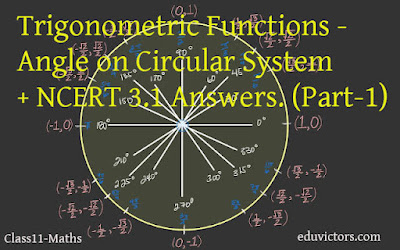Class 11 - Maths - Trigonometric Functions - Angle on Circular System + NCERT 3.1 Answers. (Part-1)
You should remember
1. In the sexagesimal system, we measure angles in degrees, minutes and seconds.
1 right angle = 90°
1° = 60′ (minute) and
1′ = 60′′ (second)
2. In the circular measure, we measure angles in radians.
Thus,
πc = 180°
3. If an arc of length l makes an angle $θ^c$ at the centre of a circle of radius r, we have
$θ = \frac{l}{r}$
4. A radian is a constant angle
5. If the length of an arc is equal to the circle's radius, then the angle subtended at the circle's centre will be one radian. One radian is denoted by $1^c$ and $1^c$ = 57° 16′ 22′′ c approximately.
Q1. Find the radian measures corresponding to the following degree measures:
(i) 25° (ii) – 47°30′ (iii) 240° (iv) 520°
Answer:
(i) 25°
180° = π radians
25° = $\frac{\pi}{180} \times 25 = \frac{5\pi}{36}$ radians
(ii) – 47°30′
= $–(47° + \frac{1}{2}°) = \frac{-95}{2}$
= $\frac{-95}{2} \times \frac{\pi}{180}$
= $\frac{-19\pi}{72}$
(iii) 240°
= $240 \times \frac{\pi}{180}$
= $\frac{4\pi}{3}$
(iv) 520°
= $520 \times \frac{\pi}{180}$
= $\frac{26\pi}{9}$
Q2. Find the degree measures corresponding to the following radian measures. (Use $\pi = \frac{22}{7}$)
(i) $\frac{11}{16}$
(ii) -4
(iii) $\frac{5\pi}{3}$
(iv) $\frac{7\pi}{6}$
Answer:
(i) $\frac{11}{16}$
= $\frac{11}{16} \times \frac{180}{\pi}$
= $\frac{11}{16} \times \frac{180}{\frac{22}{7}}$
= $\frac{11}{16} \times \frac{180 \times 7}{22}$
= $\frac{315}{8}$
= $39\frac{3}{8}$
= 39°22′30′′
(ii) -4
= $-4 \times \frac{180}{\pi}$
= $-4 \times \frac{180}{\frac{22}{7}}$
= $-4 \times \times \frac{180 \times 7}{22}$
= $-\frac{2520°}{11}$
(iii) $\frac{5\pi}{3}$
= $\frac{5\pi}{3} \times \frac{180}{\pi}$
= 300°
(iv) $\frac{7\pi}{6}$
= $\frac{7\pi}{6} \times \frac{180}{\pi}$
= 210°
Q3. A wheel makes 360 revolutions in one minute. Through how many radians does it turn in one second?
Answer: No. of revolutions made by the wheel in 1 minute (60 secs) = 360
No. of revolutions in 1 second = 360/60 = 6
The wheel turns at an angle of 2π radian in one complete revolution.
In 6 complete revolutions, it will turn an angle of = 6 × 2π = 12 π radian
Thus, in 1s, the wheel turns at an angle of 12π radian.
Q4. Find the degree measure of the angle subtended at the centre of a circle of radius 100 cm by an arc of length 22 cm. (Use $\pi = \frac{22}{7}$)
Answer: r = 100cm
l = 22 cm
θ = $\frac{l}{r}$ radians
θ = $\frac{22}{100} \times \frac{180}{π}$ degrees
θ = $\frac{126°}{10}$ = 12°26′
Q5. In a circle of diameter 40 cm, the length of a chord is 20 cm. Find the length of the minor arc of the chord.
Answer: diameter = 40cm
r = 20cm
Thus the two radii and the chord forms an equilateral triangle.
∴ θ = 60° = $\frac{π}{3}$
l = rθ = $20 \times \frac{π}{3}$
l = $20\frac{π}{3}$
Q6. If in two circles, arcs of the same length subtend angles 60° and 75° at the centre, find the ratio of their radii.
Answer: Given, θ₁ = 60° and θ₂ = 75°
Let r₁ and r₂ be the two radii.
Since arc length(l) is equal and l = rθ
∴ r₁θ₁ = r₂θ₂
∴ $\frac{r₁}{r₂} = \frac{θ₂}{θ₁}$
= $\frac{75}{60} = \frac{5}{4}$
Thus the ratio is 5:4
SETS (VENN DIAGRAMS)
SETS (Operations of Sets)
SETS (NCERT Ex 1.4 Q1-Q5)
SETS (NCERT Ex 1.4 Q6 - Q8)
SETS (NCERT Ex 1.4 Q9 - Q12)
SETS (NCERT Ex 1.5)
SETS (NCERT Ex 1.6)
Laws of Set Operations
Ch2: Relations and Functions (1 Mark Q & A) Part-1
Ch2: Cartesian Product of Two Sets (Important Points)
Ch2: Relations - Domain, Range and Co-Domain (Solved Problems)
Ch5: Complex Numbers (Part 1) - Solved Problems


No comments:
Post a Comment
We love to hear your thoughts about this post!
Note: only a member of this blog may post a comment.